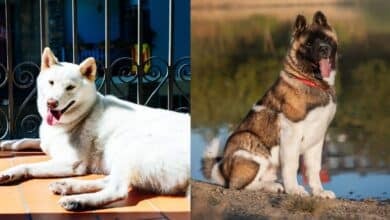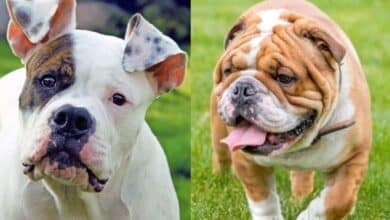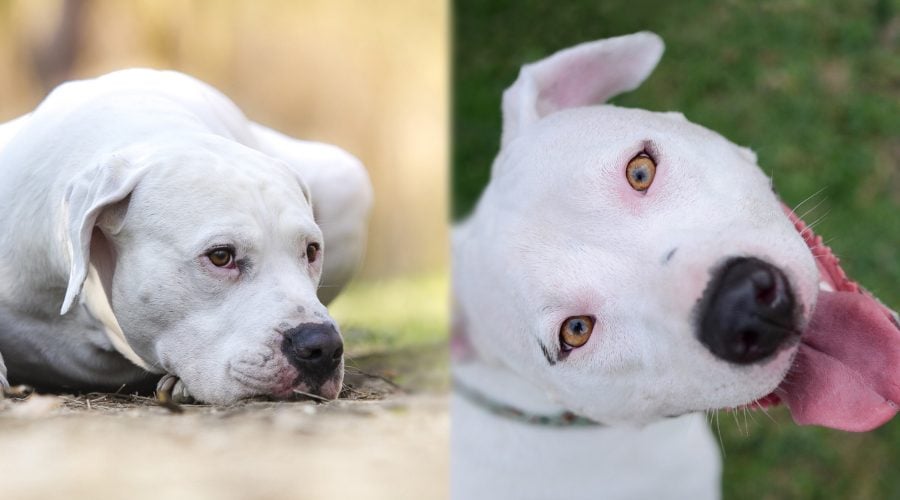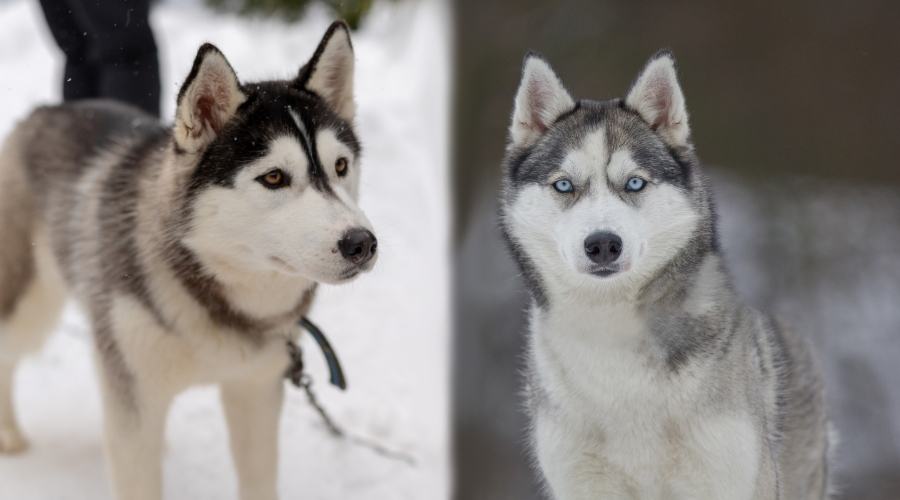Beagle vs. Labrador Retriever: Breed Differences & Similarities
When you purchase through links on our site, we may earn a commission. Here’s how it works.
Are you comparing the Beagle vs. the Labrador Retriever as your next four-legged best friend? These two dog breeds are among the most popular in the United States because of their friendly temperaments and enthusiasm. They are popular as family companions and are two of the most popular hunting dog breeds.
Table of Contents
The two breeds may have similar temperaments, but you need to understand the breeds more thoroughly before you deem them interchangeable. While bred for similar purposes, Beagles and Labradors differ in appearance, grooming needs, training requirements, and long term health. While their personalities may seem similar, here, we’ll walk you through what makes Beagles and Labradors unique.
So, whether you’re deciding between a Beagle and a Labrador as your next dog or want to know what makes them different, you’ve landed in the right place. Both breeds are loyal and energetic friends, but we’ll dive a little deeper to show you what you can expect before you bring one home.
Breed Comparison
- Height13-15 Inches
- Height21-25 Inches
- Weight18-30 Pounds
- Weight55-80 Pounds
- TemperamentLoving, Friendly, Inquisitive
- TemperamentLoyal, Friendly, Intelligent
- EnergyAverage
- EnergyHigh Energy
- HealthAverage
- HealthAverage
- Lifespan10-15 Years
- Lifespan10-12 Years
- Puppy Prices$1,000 and Up
- Puppy Prices$1,000-$3,000
Breed History
Today, both dog breeds are ever popular in the United States and beyond, but it didn’t always start that way. They were bred in different countries and served as hunting companions for many decades before becoming the beloved household pets that they are today. In fact, because both breeds are so well known, they are often combined to make one very interesting doggy mix! Let’s learn a bit more about the history of each breed.
Beagle

During the eighth century, the Talbot hound was created from the original St. Hubert hound as a better version of the hunting dog. However, the Talbot hound lacked the speed necessary to chase and capture its prey. The hound was bred with the Greyhound during the 11th century to fix this significant flaw. This pairing led to the creation of the Southern Hound.
Centuries later, during the 1700s, the need for the perfect hunting dog grew traction. The Southern Hound, still lacking speed, was bred with the Northern Country Beagle, which lacked the necessary scent capabilities. However, the breeding was far from over. The need to perfect the hunting dog continued into the 1800s as Great Britain’s Reverend Philip Honeywood created a breeding program.
While the program continued over the decades and didn’t keep records of the breeds, some believe that the original Beagle started here. The Beagle was later introduced to the U.S. and has since become a popular breed for households and hunters nationwide.
Labrador Retriever
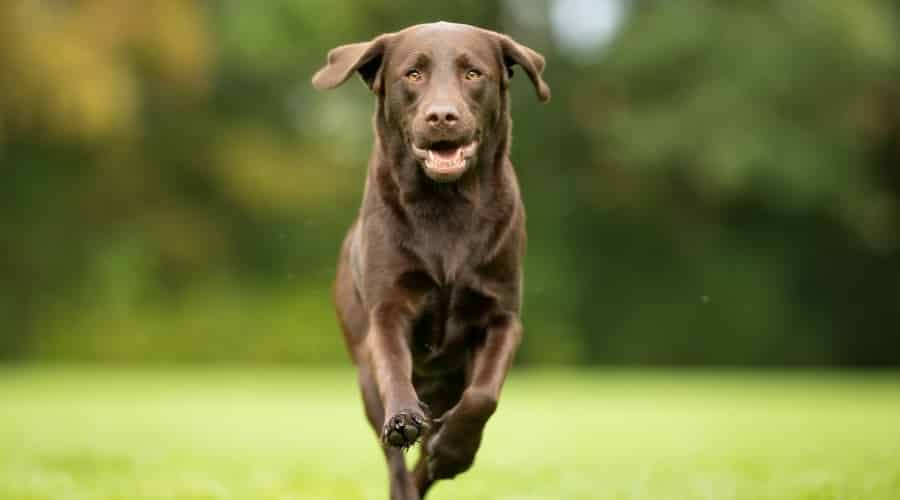
Originally known as the St. John’s dog in its native land, Newfoundland, breeders bred the Lab as a companion for fishermen. Because of their keen ability to retrieve, Labradors are the ideal first mate, retrieving fish, hauling nets, and fetching ropes.
Throughout Canada, the breed participated in a random mix of breeding with unknown working-class dogs resulting in various breeds such as the Chesapeake Bay Retriever, the Landseer, the Flat-coated Retriever, and the Newfoundland dog. However, the St. John’s dog remains accredited with the eventual Labrador Retriever we know today.
After gaining recognition from the Lords in England, people exported the dogs from Canada to Britain, where hunters took advantage of their fetching abilities. In Britain, the dog dropped the name St. John’s dog and became the Labrador Retriever. And, after a few decades, the British refined and standardized the breed.
Appearance
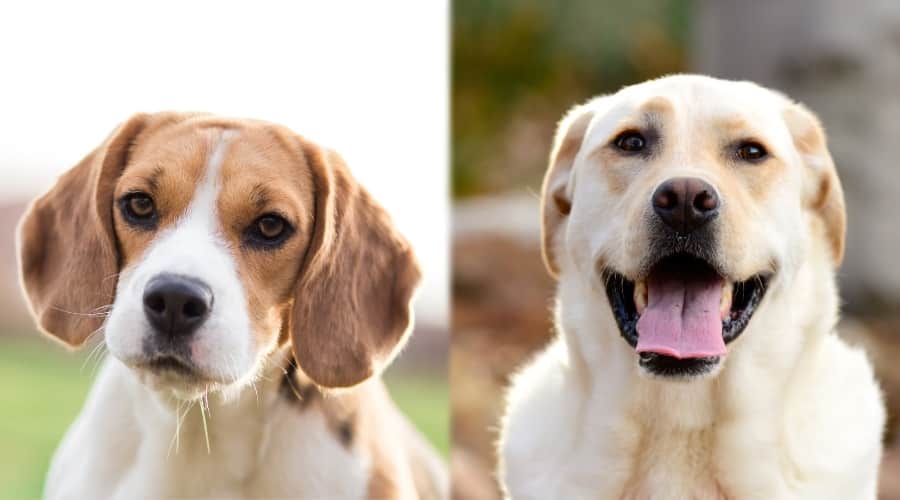
The two breeds have similar capabilities regarding hunting and physical attributes such as snout length and tail length. However, similarities aside, the Beagle and Labrador differ significantly in appearance.
The Beagle weighs, on average, between 20 and 30 pounds and stands about 13 to 15 inches tall, for starters. Their petite stature allows them to gain speed and follow prey quickly on foot. On the other hand, the Labrador retriever averages around 55 to 80 pounds and stands anywhere between 21 and 25 inches. The Labrador’s size and strength allow them to endure long hunts and challenging conditions.
Aside from size, the breeds differ dramatically in coat coloring. The Beagle has red and black spots amid a white coat, while the Labrador remains monochrome in its three potential colors: yellow, chocolate, and black. There are also two controversial coat colors, which have divided many Labradors breeders. Some breed purists argue that Red Fox Labs aren’t in-line with the breed standard and that Labs with silver coats are also not purebred.
The breeds’ coats also differ in their levels of thickness. Both are coarse and durable, but the Labrador has an incredibly thick, double-layered coat to protect it from the icy Atlantic waters and harsh Canadian winters.
While both breeds have long, wagging tails, the Labrador’s is dense with a coarse fur coat to serve as a rudder. Since the Lab is a champion swimmer, its tail is vital in helping it navigate still and bustling waters.
Temperament
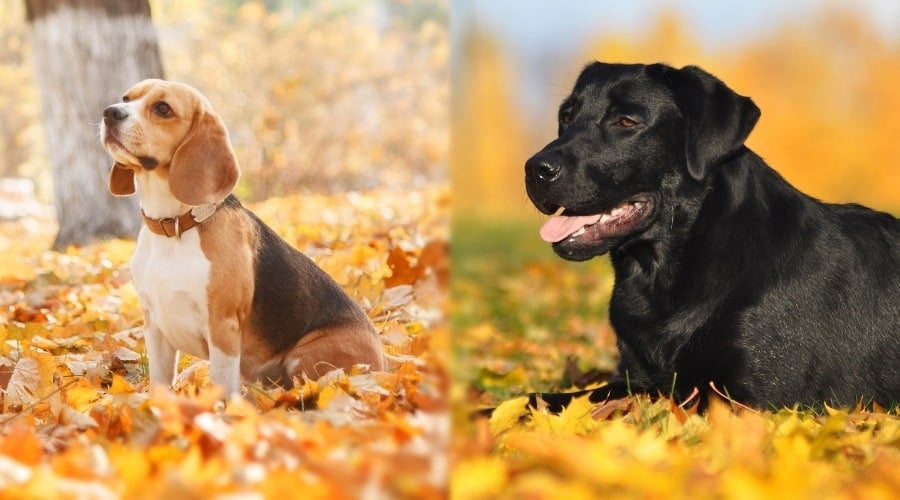
Both the Beagle and Labrador are famously friendly breeds, rightfully so since they were both bred as companion hunters. Because of their social nature, they both do well in household and family settings. Both are playful, loving, loyal dogs.
In particular, the Labrador has an easy-going personality due to its friendly nature and has a high-energy mindset. This dog, having been bred for hunting and retrieving, can play endlessly.
Similarly, the Beagle is also very energetic. While they may not require as much exercise and playtime as the Labrador, they still require a substantial amount of playtime to release its pent-up energy.
Since people initially bred them to hunt in packs, the Beagle is welcoming to groups and does well in social settings reminiscent of its pack. The Labrador is also comfortable in social settings. They tend to quickly acclimate to groups and families, making them the ideal social companion and household dog.
Exercise
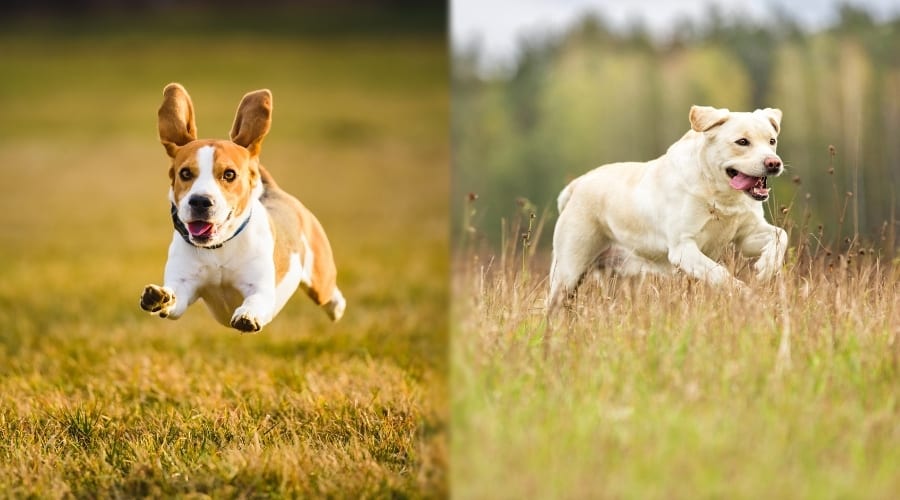
Since both breeds originated as a need for hunting companionship, they both require significant playtime to release their abundance of energy, whether it’s an endless game of fetch in your backyard or letting them accompany you on runs. Typically the Lab will need a minimum of 60 minutes of outdoor activity each day, while Beagles will be fine with a minimum of 45 minutes.
Labradors who don’t get the amount of activity in their lives as required will suffer physically and mentally. They will also most likely result in destructive, ill-mannered behavior as a means of releasing pent-up energy. To counteract these possibilities, make sure you allow time in your day dedicated to playing with your pup. Labradors enjoy swimming, retrieving, tracking, and hunting.
Beagles are wanderers, so you’ll likely want to spend time with them outdoors. They aren’t the best breed to just let off-leash in your yard if it’s unfenced. Labs also shouldn’t be left outdoors in unfenced yards, as they are less of a scenthound, but are highly alert and like to explore their surroundings.
When walking your Beagle, you also shouldn’t let them off-leash. Since Beagles have a strong sense of smell, they may take off after a scent if they’re able to roam freely. It’s best to keep your Beagle company during playtime to keep them entertained, keep them safe, and keep track of their exercise time.
Training
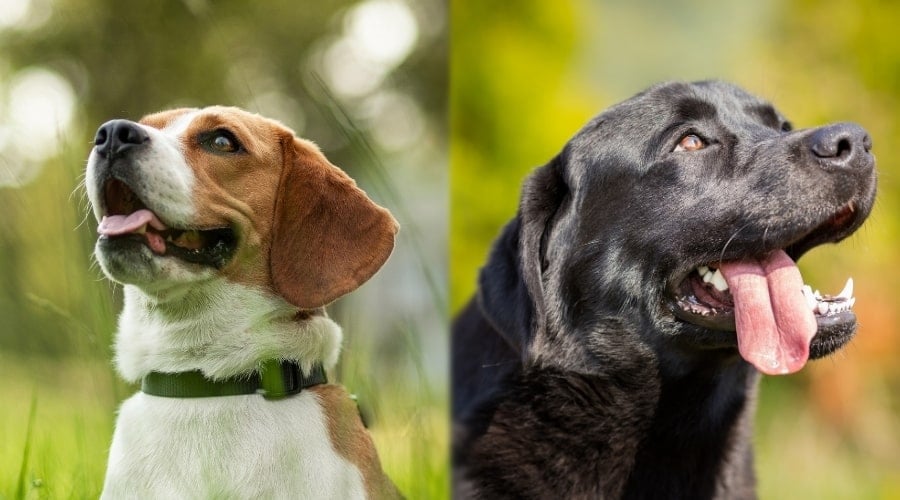
Due to their history, both breeds are accustomed to training; without it, they wouldn’t have been much help during hunts. It’s best to start training the breeds early; the sooner, the better, especially to build sociability.
Labs are loyal, enthusiastic, high-energy dogs that need you to include socialization in fun activities often. That’s why it’s best to socialize them very early. At a young age, take them to puppy training classes or if you choose to do so on your own, slowly introduce them to new dogs. Ease them into it.
For Beagles, the breed requires early on-set training as well. Since they are accustomed to pack hunting, they’ll want to gain social skills. As for obedience training, Beagles also respond well to positive reinforcement and treats. Using harsh language and an intense demeanor will only result in stubbornness.
When it comes to walking, we recommend harness training both dog breeds. Beagles need a smaller harness compared to a Lab’s harness, and both breeds like to pull. But they both respond well to quick corrections, and their eagerness to please make them easier to leash train than other breeds.
Health
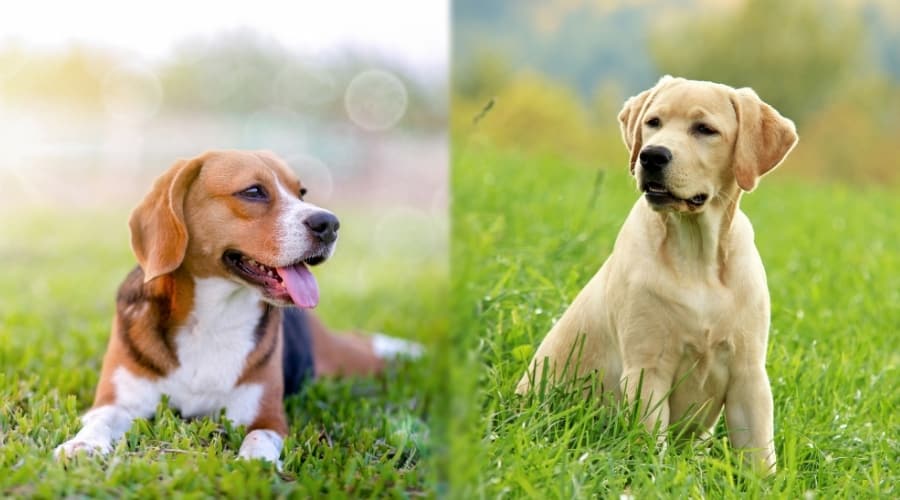
Overall, Labs are healthy dogs, but that’s not to say that there aren’t potential health risks for the breed. Experts suggest that owners get specific screenings from the vet for hip evaluation, elbow evaluation, ophthalmologist evaluation, and an exercise-induced collapse (EIC) DNA test.
Labs usually live until they are at least 10 years old, oftentimes as much as 12-13 years. Beagles usually live a little longer because of their smaller size, and it’s not uncommon to find them living upwards of 13-15 years if they are well taken care of.
EIC is a possibility in young labs. The condition is a genetic neuromuscular disorder that results in collapse from intense exercise. Labs may develop bloat, too, a life-threatening condition that fills a dog’s stomach with gas and makes it flip.
Labradors are also at high risk of developing cataracts later in life. This condition means that their vision becomes cloudy, eventually to the point of blindness. With a close evaluation of your Lab’s behavior, early screenings, and regular vet check-ups, your Lab can live a happy and healthy life.
As with Labradors, Beagles are a relatively healthy breed but still require the appropriate screenings from your vet for epilepsy, hip dysplasia, eye disorders, dislocated kneecaps, and hypothyroidism.
Beagles are predisposed to a back condition known as intervertebral disc disease (IVDD), which leads to back pain and immobility. Also, you should check Beagles’ ears weekly, and keep their teeth brushed regularly.
Nutrition
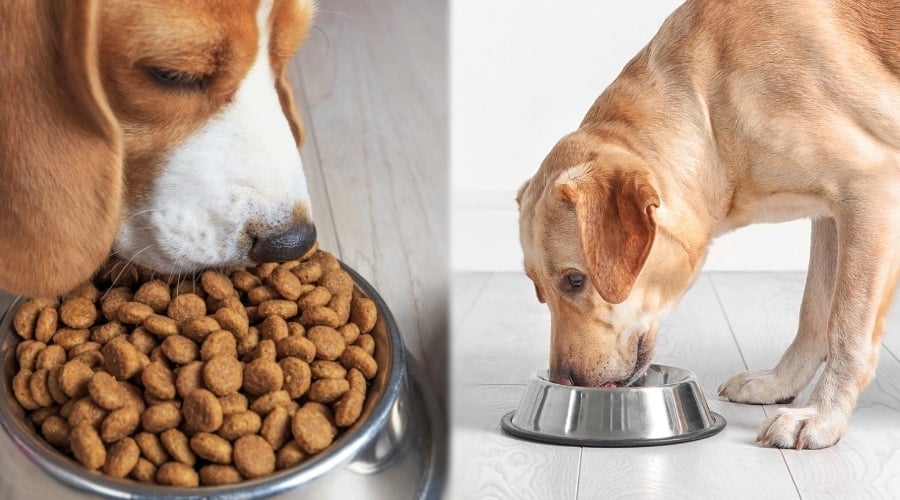
To keep these breeds healthy and happy, they need the right nutrition. The proper dog food is necessary for cell maintenance and growth and gives the dog the energy it needs to stay healthy. No matter the food, dogs of all breeds require a certain amount of fats, proteins, carbohydrates, vitamins, and minerals in their diet.
Both breeds will benefit from high-quality dog food, whether the food is manufactured or made from scratch at home, with the guidance and approval of a veterinarian. Before purchasing or making, ensure you incorporate the appropriate portions of fats, proteins, carbohydrates, vitamins, and minerals.
Labradors eat anywhere from 2 to 4 cups of high-quality dog food per day, depending on their activity levels. Beagles will eat around 1.5 to 3 cups of dog food per day, also depending on how active they are. Some Beagle food formulas are low-calorie since this breed is known to gain some weight as they age.
Both breeds are active, high-energy breeds. This means they need food with an appropriate amount of fat for energy and protein to promote cell growth. These are important for both breeds because they need the stored energy for exercise, cell growth maintenance, and development. However, it’s essential, especially for Labs, to not receive too much fat in their diet as Labs are predisposed to obesity.
Most Labrador dog foods should contain DHA and Taurine, which help eye development since the breed is at high risk for developing cataracts. Beagle’s would benefit from an amount of food with Chondroitin and glucosamine, which aids the cartilage in joints since Beagles are susceptible to hip dysplasia and dislocated knee caps.
Grooming
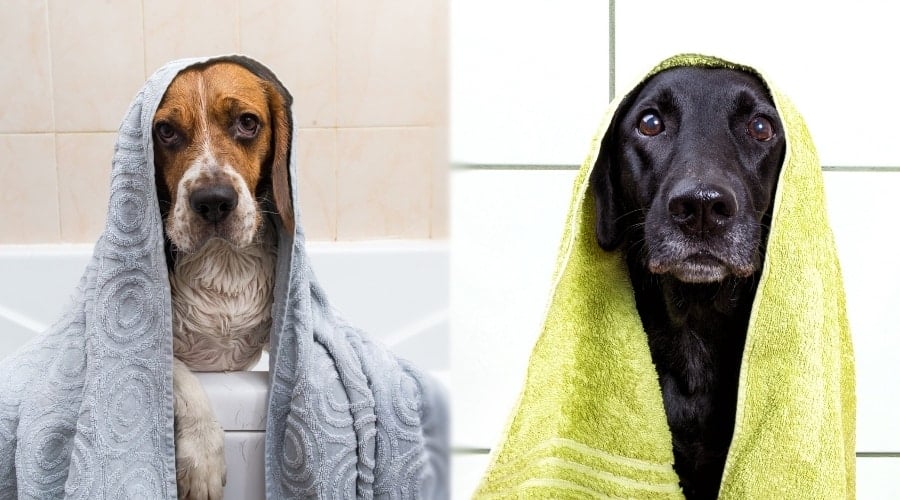
Both breeds have relatively coarse coats. This means that their fur is thicker in the winter to protect them from harsh climates, but quickly and frequently sheds in the spring. However, Beagles tend to shed occasionally year-round too. To keep the Beagle’s shedding in check, it would be best to brush it at least twice weekly with a medium bristle brush or a grooming mitt to catch any loose hair.
Labradors, a bit more low maintenance, would still benefit from weekly brushing, just not as frequently as Beagles. Because Labs also shed copiously during the spring and the year, they would also benefit from the same grooming tools as necessary for Beagles.
The Labradors’ low maintenance comes from it’s coarse, water-repellent coat. Because of their fur, you don’t have to bathe them as frequently as they get brushed; however, it’s still a good idea to clean them from time to time. Similarly, Beagles don’t need frequent baths either, preferably only if they roll in or get into something incredibly messy outside.
Puppy Prices
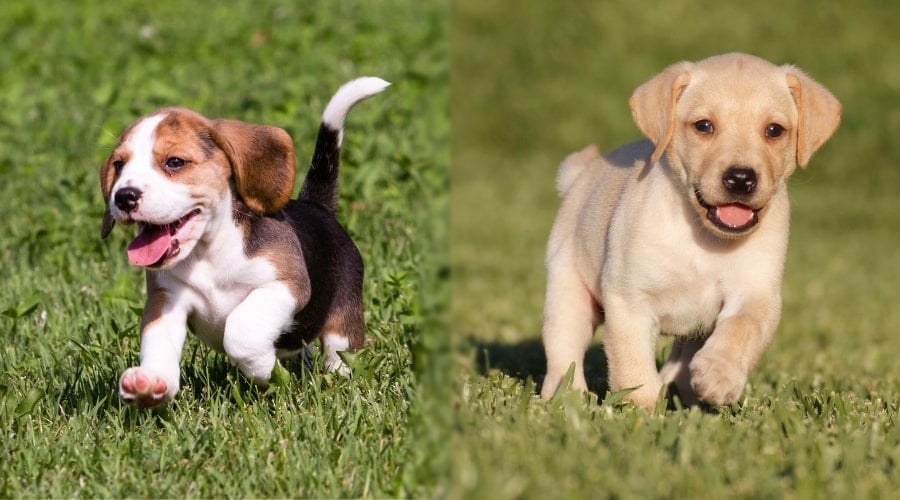
Both breeds cost relatively the same amount when purchased from a reputable breeder or adopted from a shelter. The price of a puppy can range anywhere between $1,000 and $3,000 if adopting from a breeder with AKC papers. We’d recommend you avoid adopting from breeders known as “backyard breeders” who are typically more interested in profits than they are the health and longevity of the breeds.
It’s worth noting that Labradors that have a specialty coat color can be more expensive. Labs with silver coats and Labs with red coats are usually more expensive. While these coat colors aren’t without controversy in the breeding community, they are still priced higher than many black, yellow, or chocolate Labs.
If you are buying a puppy from a championship line from either dog breed, expect to pay closer to $3,000 or more. If chosen to adopt from a rescue, the price will reduce significantly. For companionship dogs, we recommend checking with local rescue groups before you adopt if you are open to a rescue dog. Typically rescue centers for both the Lab and Beagle charge around $300 to $500 for adoptions. Most are non-profit.
Final Thoughts
Both dog breeds are famously friendly companions for a reason. They both do well with children, and are easily trainable. Because of their popularity, their puppy prices are also slightly lower than other rarer and more obscure dog breeds.
Both breeds are high energy, and you’ll need to have time in your day to entertain and exercise your pup. If size matters, Beagles are perfect smaller family companions, and Labs make wonderful family companions in a larger body.
Ultimately, both breeds are excellent for families and make wonderful hunting companions. Either breed can adapt to most living situations, so it comes down to figuring out which breed better fits your lifestyle.
